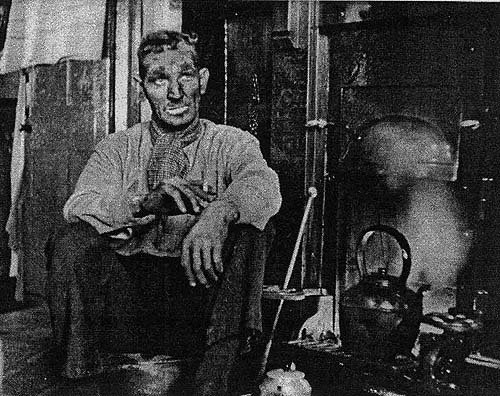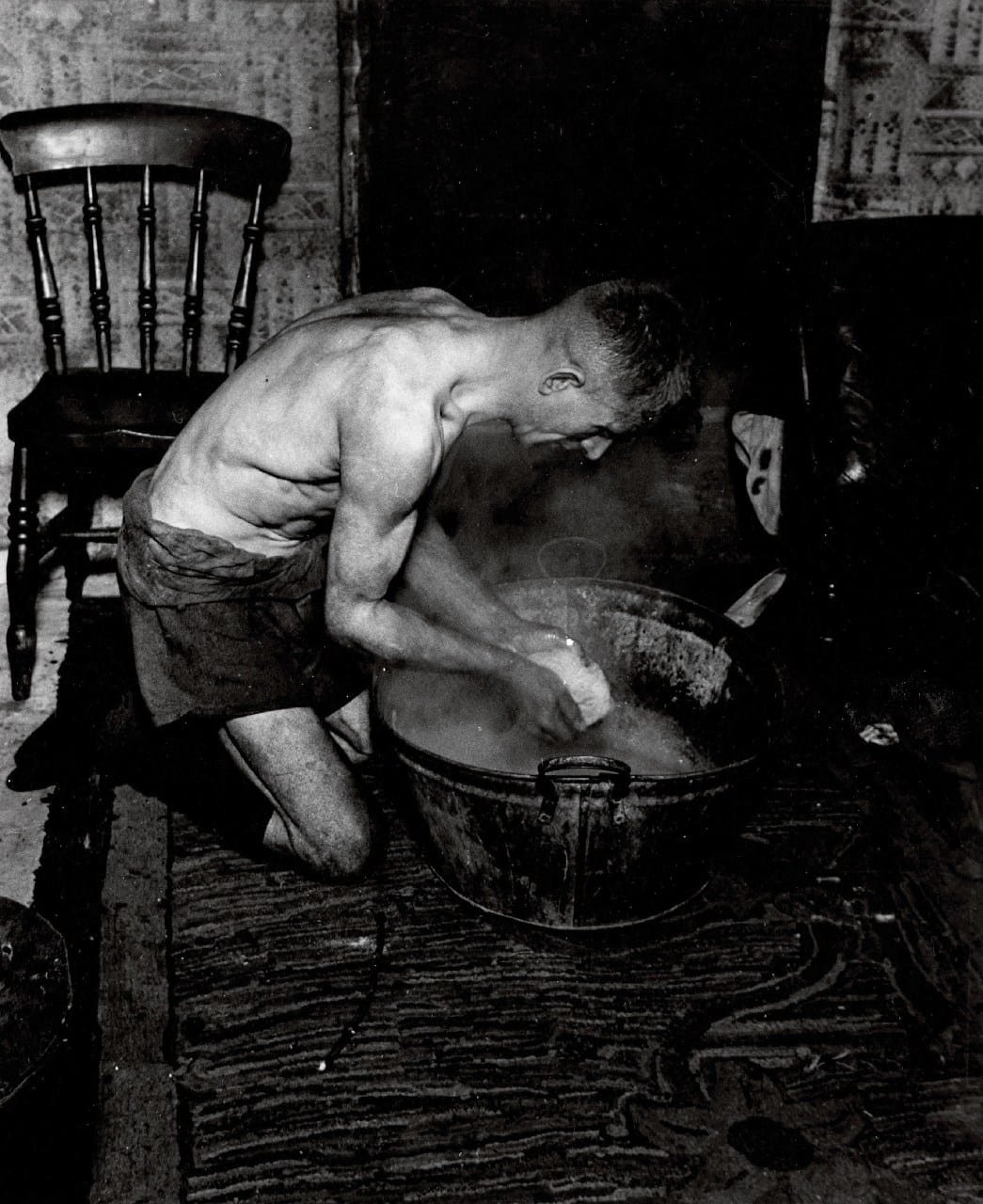The Power of Tenderness: Bill Brandt’s 1937 Photograph of a Coal Miner’s Bath
In 1937, renowned British photographer Bill Brandt captured a poignant and intimate moment in the life of a coal miner in Chester-Le-Street, Durham, England. The image, which shows a young woman bathing a coal miner at home, is a stark yet deeply human portrayal of the physical toll of manual labor and the tender care that existed within working-class families during that time.
A Moment of Vulnerability Amid the Hardships of Labor
In the photograph, the miner, hunched over in a large basin, is covered in grime—his body a testament to the grueling conditions of coal mining. His expression is one of fatigue, and the dirt on his skin tells a story of the harsh physical labor he endures daily. The young woman attending to him, dressed in a simple apron, performs the act of washing with a quiet tenderness that contrasts sharply with the toughness of the miner’s job.

The image speaks volumes about the resilience of the human spirit. The act of bathing, typically mundane, becomes something more in this context. It highlights the stark realities of working-class life, particularly for coal miners whose physical labor often left them exhausted and covered in soot. In a time when hygiene and personal care were deeply significant but also difficult to maintain due to the nature of their work, this moment of care becomes a powerful symbol of both physical and emotional rejuvenation.
Living Conditions of Coal Miners in the 1930s
The setting of the photograph further intensifies the impact of the image. The room is modest and working-class—simple furnishings, a stove for warmth, and the bare essentials for living. In the background, there’s a sense of familiarity and routine, despite the harshness of the miner’s job. The home is a space of recovery, not just from physical exhaustion, but also from the emotional weight of laboring in dangerous, unsanitary, and difficult conditions.
The socio-economic conditions of the time—during the height of the Great Depression—are mirrored in the modest interior of the home. Working-class families, particularly those reliant on labor-intensive industries like coal mining, often faced poverty, long hours, and challenging living conditions. Despite these hardships, family roles were clearly defined, and caregiving played a central role in household life. In this photograph, the woman’s act of caring for the miner becomes a statement on the unspoken strength of women in such households, holding the family together through emotional and physical support.
The Role of Women in Caregiving
The tender act of bathing in Brandt’s photograph also underscores the significant role women played in maintaining their families. The woman in the image, though not identified, represents countless women of that era who were responsible for the physical and emotional well-being of their families. In a time when gender roles were often rigidly defined, women’s care work was essential in keeping the household running, yet often went unnoticed or underappreciated.
Brandt’s image serves as a visual meditation on the strength and quiet resilience of women, especially in working-class environments where their efforts were often more practical than celebrated. This caregiving role was not just about physical cleanliness but also about offering emotional support to those who labored under grueling conditions.

Bill Brandt’s Exploration of the Working Class
Bill Brandt was known for his unflinching exploration of the lives of the working class, particularly during the early and mid-20th century. His photography often captured the contrasts between vulnerability and strength, tenderness and hardship. In this iconic photograph, Brandt presents the dichotomy of labor and love—grit and grime juxtaposed with the tenderness of human connection. Through his lens, he immortalized moments that told deeper stories of socio-economic struggles, resilience, and familial bonds.
In a time when the working class often went unseen, Brandt’s images gave them a voice. His portrayal of coal miners and their families captured not just their struggles but their humanity. This photograph, in particular, is a stark reminder that behind every calloused hand and soiled face, there was a family, a story of connection, and moments of care that held them together.
Conclusion: A Reminder of Humanity’s Resilience
Bill Brandt’s 1937 photograph of a coal miner being bathed is more than just an image of physical labor. It is a touching reminder of the tenderness that exists in the most unlikely of circumstances. Through this powerful portrayal, we see both the hardship of manual labor and the quiet strength of caregiving. In a world that often overlooks the struggles of the working class, Brandt’s photograph serves as a powerful testament to human connection, resilience, and the enduring spirit of love and care.
In the end, this image invites us to reflect on the importance of compassion and the strength of ordinary people facing extraordinary challenges. It is a beautiful example of how photography can not only capture a moment in time but also speak to the universal themes of humanity.
